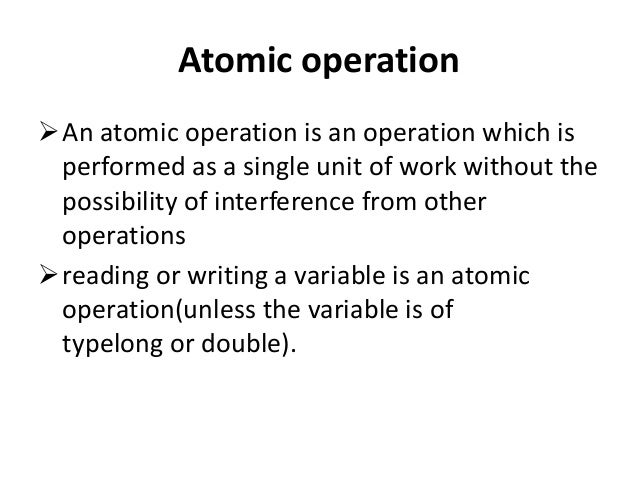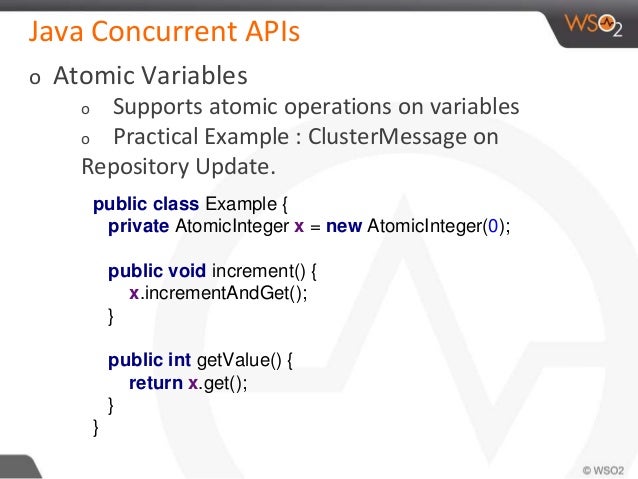Atomic operations are performed in a single unit of task without interference from other operations.
Atomic operations are necessity in multi-threaded environment to avoid data inconsistency.


The Java language specification guarantees that reading or writing a variable is an atomic operation(unless the variable is of type long or double). Operations variables of type long or double are only atomic if they declared with the volatile keyword. .
Assume i is defined as int. The i++ (increment) operation it not an atomic operation in Java. This also applies for the other numeric types, e.g. long. etc).
The i++ operation first reads the value which is currently stored in i (atomic operations) and then it adds one to it (atomic operation). But between the read and the write the value of i might have changed.
Since Java 1.5 the java language provides atomic variables,
e.g. AtomicInteger or AtomicLong which provide methods like getAndDecrement(), getAndIncrement() and getAndSet() which are atomic.
Example without Atomic,
Let’s create a simple multi-threaded program where every thread increments the shared count variable 4 times. So if there are two threads, after they finish count value should be 8.
public class JavaAtomic {
public static void main(String[] args) throws InterruptedException {
ProcessingThread pt = new ProcessingThread();
Thread t1 = new Thread(pt, "t1");
t1.start();
Thread t2 = new Thread(pt, "t2");
t2.start();
t1.join();
t2.join();
System.out.println("Processing count=" + pt.getCount());
}
}
class ProcessingThread implements Runnable {
private int count;
@Override
public void run() {
for (int i = 1; i < 5; i++) {
processSomething(i);
count++;
}
}
public int getCount() {
return this.count;
}
private void processSomething(int i) {
// processing some job
try {
Thread.sleep(i * 1000);
} catch (InterruptedException e) {
e.printStackTrace();
}
}
}
If you will run above program, you will notice that count value varies between 5,6,7,8. The reason is because count++ is not an atomic operation. So by the time one threads read it’s value and increment it by one, other thread has read the older value leading to wrong result.
Example with Atomic operation,
import java.util.concurrent.atomic.AtomicInteger;
public class JavaAtomic {
public static void main(String[] args) throws InterruptedException {
ProcessingThread pt = new ProcessingThread();
Thread t1 = new Thread(pt, "t1");
t1.start();
Thread t2 = new Thread(pt, "t2");
t2.start();
t1.join();
t2.join();
System.out.println("Processing count=" + pt.getCount());
}
}
class ProcessingThread implements Runnable {
private AtomicInteger count = new AtomicInteger();
@Override
public void run() {
for (int i = 1; i < 5; i++) {
processSomething(i);
count.incrementAndGet();
}
}
public int getCount() {
return this.count.get();
}
private void processSomething(int i) {
// processing some job
try {
Thread.sleep(i * 1000);
} catch (InterruptedException e) {
e.printStackTrace();
}
}
}
Benefits of using Atomic Concurrency classes is that we don’t need to worry about synchronization at each and every place.
We are dealing with integers and it’s assumed to be more efficient that synchronization which involves locking resources.
No comments:
Post a Comment